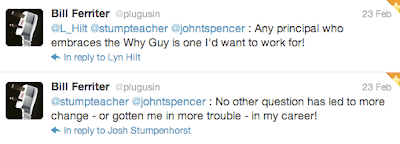The following guest post was written by Mark Pullen, an elementary teacher in a 1:1 classroom in East Grand Rapids, Michigan.
The
infusion of technology into the classroom has the potential to be the
greatest change agent in K-12 education for the foreseeable future.
As a result, I believe that one of the most important goals for
today’s principals must be helping their technophobic teachers to
learn to utilize technology more effectively. Here are four ways in
which principals can do just that:
Set
clear technology goals: While this will be
important to all of your staff members, this will especially aid the
struggling teacher. Don’t be vague: “All students at Lincoln
Middle School will learn to become active digital creators and safe
web 2.0 citizens” may be fine language for your building’s
official tech plan, but to the technophobic teacher, it means little.
Find
in-house technology mentors: Mentors aren’t
only for new teachers. Identify your best technology mentors and
pair them up with teachers who need extra help. Students can be used
to mentor other students as well; for example, in the elementary
grades, schools often designate “reading buddies” – older
students who pair up with younger students to read with them. For
elementary principals reading this, why not encourage the creation of
a “technology buddies” program where your older students pair up
with younger ones to help them learn some core technology skills?
Focus
on key proficiencies, not ever-changing sites and tools: Help
your technophobe teachers to understand that the goal isn’t
necessarily to have students learn Prezi, Glogster, VoiceThread,
Animoto, and Adobe Premiere by the end of the semester; rather, it is
to have students become comfortable with presenting their learning in
a digital form. The specific sites and tools will change too quickly
for the technophobic teacher to ever feel confident in understanding
them, but the core student competencies needed will generally remain
more stable from year to year.
Create
differentiated professional development opportunities: Your
technophobic teachers need to be met where they are and brought
forward from there. Too often, I’ve seen professional development
that is far too complex for some teachers and far too simple for
others. I’ve seen teachers that struggle to attach a file to an
email; if that’s where they’re at, professional development about
starting a classroom Ning network just won’t be helpful.
Our
mindset toward technophobic teachers should be similar to our mindset
toward struggling students: all teachers can learn, and we need to
intentionally provide those struggling teachers with instruction that
meets them where they are to help them increase their tech competence
and confidence.
About
the Author:
Mark
Pullen has been an elementary teacher for 13 years, currently
teaching third grade in East Grand Rapids, MI. He’s an advocate for
classroom technology integration, and writes extensively on that
subject on behalf of Worth
Ave Group, a leading
provider of laptop, tablet computer, and iPad insurance for schools
and universities: http://www.worthavegroup.com/education




